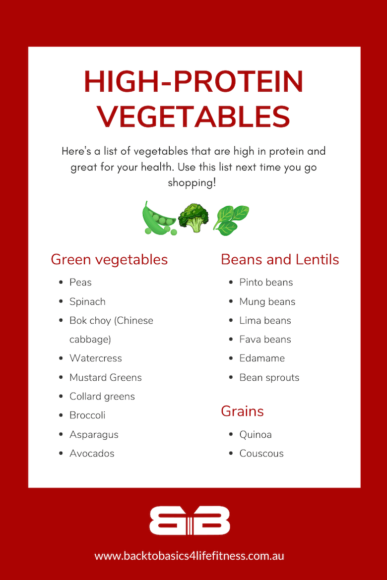
What vegetables have protein?
We all know by now that vegetables are good for us. However, did you know that some vegetables are especially great for adding more protein to your diet? Plant-based proteins are a great option not only for vegans and vegetarians, but also meat eaters out there.
Packed with nutrition and low in calories, high-protein vegetables should be a part of a healthy diet plan. If you want to start eating healthier and still achieve your fitness goals, we definitely recommend that you give these vegetables a try!
Read on to find out which vegetables have high amounts of protein in them, what other nutrients that vegetables can provide, and also some tips on making vegetables a part of your meal plan.
Which vegetables have protein in them
While all vegetables are incredibly healthy for you, here is a high protein vegetables list that shows the ones that are especially chock full of protein. Make sure to save this list into your phone for the next time you go shopping!

You’ll see that a lot of green vegetables make the cut, which shouldn’t be surprising. I suppose all our mums were onto something when they made us eat our greens, hey? We’ve also added beans, lentils, and grains into the list. There’s some discussion on whether or not they’re vegetables, but they are still vegan and vegetarian friendly, and really high in protein.
Green vegetables that are high in protein include:
- Peas
- Spinach
- Bok choy (Chinese cabbage)
- Watercress
- Mustard Greens
- Collard greens
- Broccoli
- Asparagus
- Avocados
Here are a few beans and lentils that are high in protein:
- Pinto bean
- Mung bean
- Lima beans
- Fava beans
- Edamame
- Bean sprouts
Grains like quinoa and couscous are also a healthy vegetarian option that contains a lot of protein.
What nutrients do vegetables provide?
Aside from protein, vegetables are also a fantastic source of nutrients, including potassium, fiber, vitamins A and C, as well as folate. In addition to all this, vegetables contain no cholesterol and are naturally low in fat. Whether or not you plan on having a high protein diet, vegetables should be on the menu every day. Here are a few other nutritional benefits of the high-protein vegetables we listed above.
Eating a diet rich in potassium helps you maintain a healthy blood pressure, which is important for long-term health as it can help prevent cardiovascular issues including strokes and heart problems. Leafy greens and lentils are especially high in both potassium and protein.
Dietary fiber is also an important nutrient in vegetables, because it helps things move along in your bowels, preventing constipation. Fiber is also a great way to help you feel fuller for longer, so you’ll be less likely to snack through the day, which will help you reduce your calorie intake. Avocado, broccoli, as well as beans and lentils are all really high in fiber.
Vegetables also contain Vitamins A and C. Vitamin A is important for eye health and your immune system, whereas Vitamin C is vital for dental health, helping you heal from cuts and wounds, as well as help you absorb more iron. Broccoli, kale, and mustard greens are high in vitamin C. Meanwhile, collard greens and spinach are high in Vitamin A.
Frozen vs. fresh vegetables comparison
We often have clients asking us whether it’s better to have frozen or fresh vegetables, and here’s the honest answer: there are pros and cons to each one, but the key thing to remember is just to eat plenty of vegetables in the first place – whether they’re fresh or frozen!
When it comes to frozen vegetables, they’re usually picked or harvested at their ripest and then snap frozen within hours. Because of this, they tend to maintain maximum nutrient levels. In fact, there has been research that shows that frozen vegetables can sometimes contain more nutrition compared to fresh fruits stored in the fridge for three days.
That being said, it’s still better to not boil or overcook frozen vegetables, as this will cause nutrients to leach out. To maximise the nutrition of your cooked vegetables, steam or bake your vegetables instead.
Frozen vegetables are also a lot easier to get, especially if you live somewhere rural. There are a lot of folks that don’t have access to farmer’s markets or green grocers, so frozen vegetables from a supermarket might just be more accessible.
Frozen vegetables are also less likely to go to waste, because you can keep them in the freezer for months if you need to. There’s no risk of them spoiling before you need to use them!
On the other hand, one of the benefits of fresh vegetables is that it’s a lot quicker and easier to prepare. When you’re short on time, or just need to whip up a quick meal, fresh vegetables will cook a lot faster compared to their frozen counterparts.
Fresh vegetables are also more inviting – if you think about how often you open up your fridge through the day (compared to your freezer), you’ll notice that you’re more likely to see your fresh vegetables instead of your frozen vegetables. This will make you more likely to use the vegetables ASAP!
Again, no matter if it’s fresh or frozen, vegetables should make up a large part of your diet. So whichever option is more likely to get you to eat your vegetables, then that’s the approach you need to take! However, it’s not all or nothing – you can always opt for a mix of frozen and fresh vegetables in your diet.
Using vegetables in your meal plans
By now, it should be clear that you need to maximise the amount of vegetables in your diet. But how will that look like in your daily life? Well, the best way to ensure you have enough vegetable intake is to plan ahead.
Meal plans are an invaluable tool to help you reach your health and fitness goals. It can help reduce food wastage and help you keep track of your diet, as well as make it so much more convenient for you to prepare meals for yourself and your whole family!
Take the headache out of meals by planning a week ahead of time, or get in touch with us so we can create a meal plan tailored to your specific goals. You can use meal plans to get a more accurate estimate of how many vegetables you’ll need, and what meals to use them in. Also, as we mentioned before, you can consider using up fresh vegetables at the beginning of the week, and then use frozen vegetables the rest of the week.
You can track your nutrient values by using our exclusive app. The app provides access for you to get a customised meal plan. Simply purchase any of our packages to take advantage of this offer. You can even log your meals to track how well you are going.
Here are a few other tips to help you incorporate vegetables into your diet!
- Add veggies to the meals already on your menu. So if you’re eating pasta, add some spinach or broccoli into it. Or if you love a good curry, then cook up some lentils or peas inside.
- Finely chop, or use a grinder to sneak them into your food. This is especially useful if you’ve got picky eaters that won’t eat a vegetable if it’s served up whole!
- Use vegetables as a snack throughout your day. Beans are lovely for this, as they’re quick and easy to prepare, but you can chop up some vegetables during the week to make small servings of salad too.
- Use vegetables as a replacement for other ingredients, like making zucchini pasta or using quinoa instead of rice.
How to add healthy flavour to vegetables
While some vegetables are delicious on their own, others need a little more help in the flavour department! No worries, though – there are many things you can do to make vegetables taste delicious, and they’re all easily available at your nearest supermarket.
1. Onion and garlic
A classic combination, onions and garlic will add flavour and depth to your meals with very little effort! Quick stir fries are great for this.
2. Flavoured vinegars
We love a good vinaigrette dressing! There are so many ways you can use flavoured vinegars like balsamic vinegar, wine vinegar, and apple cider vinegar in your salads, so try out different recipes.
3. Fresh herbs
Herbs like coriander, parsley, and oregano can add a lot of flavour to vegetable dishes. Fresh is best, but dried herbs can also be used if that’s all you have on hand.
4. Spices
Curry, cumin, and turmeric all have really strong flavours that can really transform your vegetable dishes. They’re also a great way to add colour and interest to your meals, making your dishes that much more appetising.
5. Chilli
Add some spice with chilli if you’ve got the guts for it! There are many varieties of chili to choose from, some spicier than others, and each with a unique flavour. So go ahead and get adventurous with this!
Eat your way to good health with vegetables
A healthy diet should always be a part of your overall health and fitness plan, and vegetables should make up the bulk of that diet. A diet that is high in protein will provide so many benefits for your body, and vegetables allow you to capitalise on that while still being really low in calories.
Are you searching for delicious high-protein recipes for your family? Well, you’re in luck because we’ve got a FREE eBook full of Meat-Free Protein Recipes. Simply sign up to our monthly newsletters to get your copy.







Leave a Comment